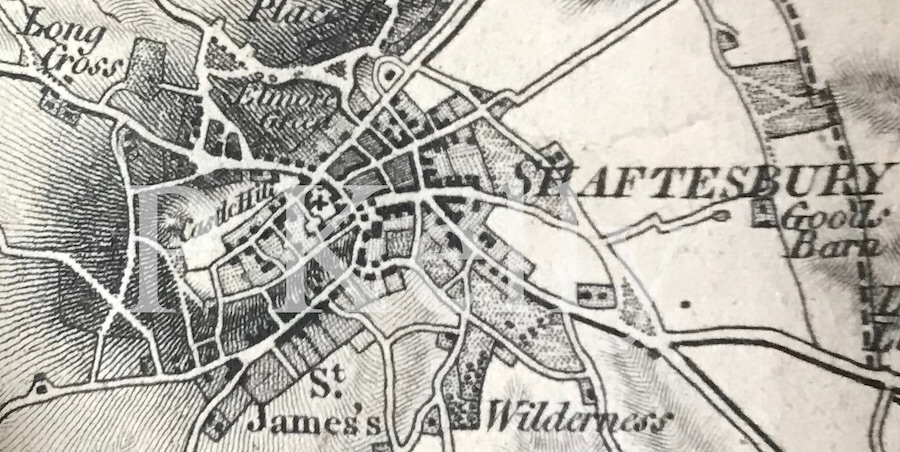The below is adapted from, and provides additional material for, my book, King Alfred: A Man on the Move, available on Amazon
It would be great if you could support this project by purchasing a copy.
Dorset was an important in the time of King Alfred. Important roles were played by Sherborne, Wimborne, Dorchester and Shaftesbury. An important engagement with the Vikings took place at Wareham. Undoubtedly, much went on that never made it into the historical sources that are available to us today. In this post I shall take a look at Shaftesbury.
King Alfred founded a nunnery at Shaftesbury and it is thought that this was at the same site as where the Normans later constructed their abbey. Although the Norman abbey is now a ruin, it is a delightful and evocative place to visit, as is the rest of the town.

Asser tells us that Alfred ordered the building of a monastery near Shaftesbury’s east gate and that his daughter Æthelgifu was appointed abbess. However, this is initially confusing because the Abbey is south-west of the centre, so it seems that it should have been by a west gate. But the modern centre appears not to align well with what was there in Alfred’s time and, when this is taken into account, the abbey was indeed at the eastern aspect of the town. The nunnery This abbey was well endowed; Asser (99-102) tells us that, in combination with the new abbey at Athelney, it received one eighth of King’s Alfred’s taxation income.
Unfortunately, no early source tells us when the nunnery was built. However, Ranulf Higden’s Polychronicon indicates that it was after Alfred had restored London, and we know from the Anglo-Saxon Chronicles that Alfred took control of London in 886. This suggests that the nunnery may have been built in 886 at the earliest and 893 at the latest (because it had to be present at the time Asser was writing, believed to be 893).

However, Higden also tells us that around the time that Alfred restored the settlement of Shaftesbury in 880, Pope Marinus sent Alfred a piece of the “true cross.” Manuscript E of the Anglo-Saxon Chronicles indicates that this was sent in 882. I found out that Marinus was pope between December 882 and May 884, indicating that the item could only have been sent in December 882. This led me to change my mind from believing that the abbey was built between 886 and 893 to a belief that it was in use by 882 or 883 because it seems plausible that the fragment of the true cross had been destined for either the new and important nunnery at Shaftesbury or the new abbey at Athelney, which was built at about the same time. In a generous attempt to make everything fit, one could argue that the nunnery might have come into use before its completion, with this being in the period 886-893, after King Alfred had restored London, although this itself must have taken some time to complete. The current location of this piece of the “true cross” is not known, although there is a reputed fragment of the true cross, which could be different to the one sent to Alfred, in St Michael and St Gudula Cathedral in Brussels, Belgium.

Shaftesbury was clearly a very important place. In 980 the nunnery became the resting place of King Edward the Martyr after he had been murdered at Corfe Castle in 978 (he was initially interred at Wareham). His shrine became a focus for pilgrimage, and perhaps this was what King Canute was undertaking when he died at Shaftesbury in 1035. In 944 the site also became the burial place of Ælfgifu, who was the first wife of King Edmund who also became venerated as a saint. Elisabeth, the wife of Robert the Bruce, King of Scotland, was also briefly held here.

A Saxon pottery kiln dating to approx 660-880 was found at or near the current Tesco car park (during investigations before the area was redeveloped) (DNHAS V129, 2008). These discoveries fit with the earlier 1976 discovery of late Saxon pottery during floor replacement in the crypt of St Peter’s Church (DNHAS V99, 1977) and a later findings of Saxon pottery fragments at Barton Hill (DNHAS V137, 2016), a site close to the location of the earlier-discovered pottery kiln, because all three sites are outside of, and to the east of, the Saxon burgh.

. From an undated “History of Shaftesbury”, Nichols and Sons, Red Lion Passage, Fleet Street

There is much more about the travels of King Alfred in my book, including maps and references. Tap or click the image below to learn more.
Many thanks to thisisalfred.com for taking an interest in my writing. Hopefully, a recorded chat that we had at the Abbey will be available soon.


